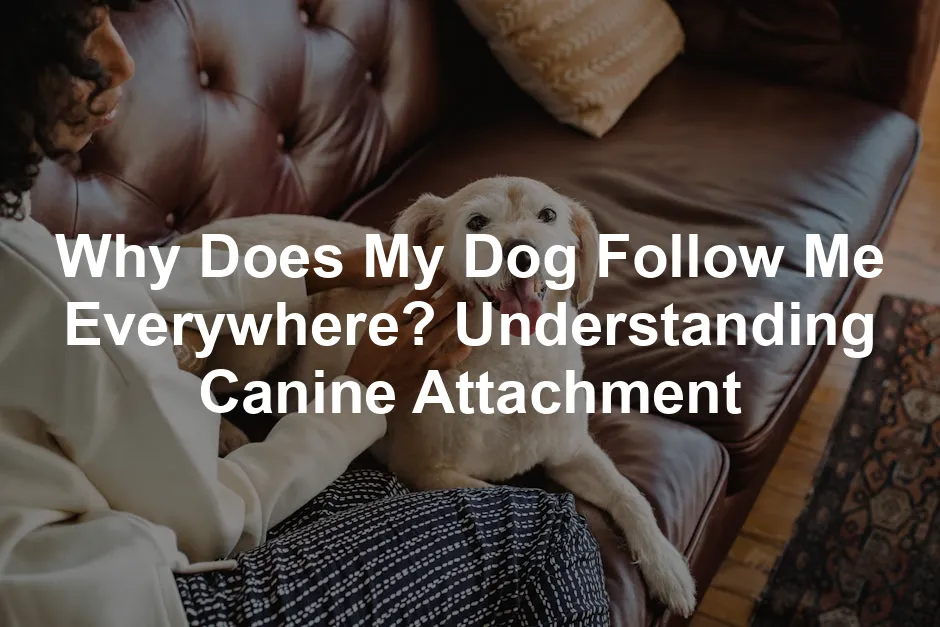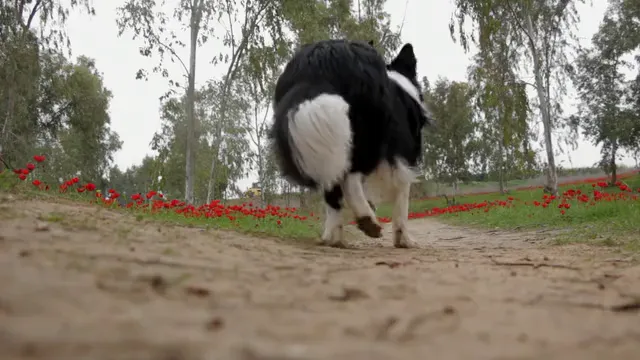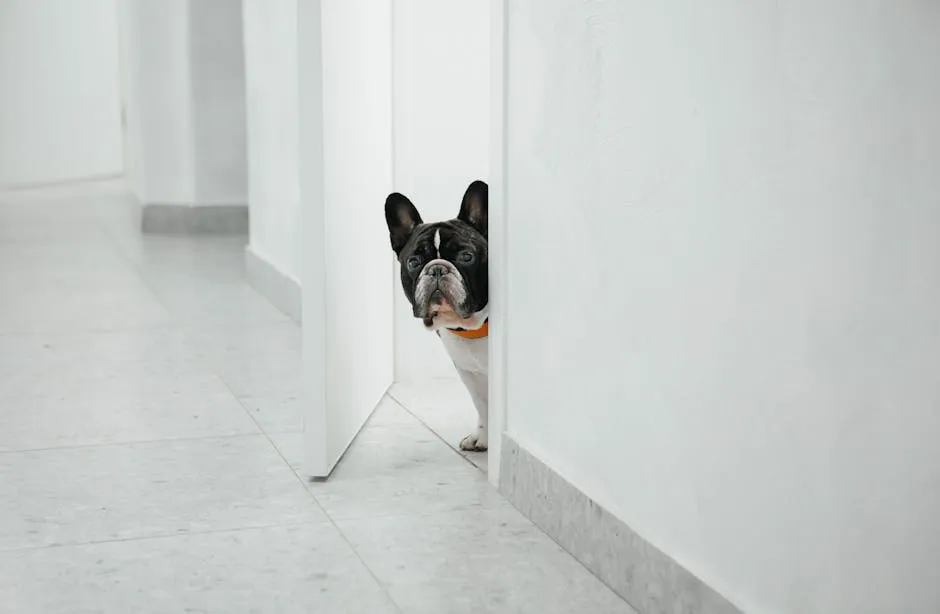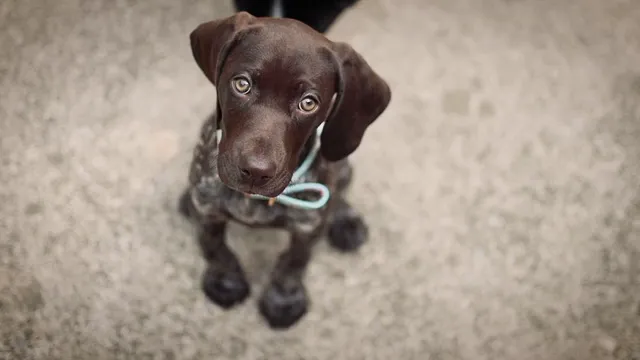
Why Does My Dog Follow Me Everywhere? Understanding Canine Attachment
Introduction
Have you ever noticed your furry friend shadowing you constantly? It’s a common behavior among dogs to follow their owners everywhere. This affectionate habit highlights their love and loyalty. Understanding why dogs do this can greatly enhance your bond with them.
If you’re looking to strengthen that bond even further, consider picking up “The Art of Raising a Puppy”. This book is a fantastic guide to understanding your pup’s needs and behaviors, ensuring a happy and healthy relationship.
Summary and Overview
Dogs are often referred to as “Velcro dogs” due to their tendency to stay close to their owners. This behavior is rooted in their social nature and pack mentality. Dogs thrive on companionship and feel secure when near their humans. Several factors can influence this behavior, including genetics, strong attachment, and even anxiety. For instance, dogs may follow you to seek reassurance or comfort during stressful situations. By grasping these reasons, you can better address your dog’s needs and improve your overall relationship. Recognizing this behavior helps create a healthy balance of closeness and independence for both of you.
To keep your furry friend engaged, consider a Dog Puzzle Toy: Outward Hound Hide-A-Squirrel Puzzle Toy. It’s a fun way to challenge their minds and keep them entertained while you get some much-needed alone time!

Understanding Canine Behavior
The Pack Mentality
Dogs are social animals with strong pack instincts. In the wild, they thrive in groups, relying on each other for survival. When you bring a dog into your home, you become part of their pack. This bond fosters loyalty and affection, making your dog want to stay close. They see you as their leader, guiding them through life. This instinctual behavior not only strengthens your relationship but also gives your dog a sense of security. They feel safer when they’re near you, reinforcing the emotional connection you share.
The “Velcro Dog” Phenomenon
A “Velcro dog” is one that follows you around like a shadow. This behavior shows a deep emotional bond. Research shows that dogs are highly attached to their owners, often seeking closeness for comfort and reassurance. In fact, studies indicate that over 60% of dogs display this clingy behavior. Certain breeds, like Chihuahuas and Golden Retrievers, tend to be more Velcro-like due to their genetics and history as companion animals. This attachment can be heartwarming, but understanding its roots helps you nurture a balanced relationship.
To provide your furry friend with a cozy spot to relax, check out the PetFusion Ultimate Dog Bed. This bed is perfect for giving them their own space while still being close to you!

Reasons Dogs Follow You
Social Nature
Dogs are inherently social beings. They thrive on companionship and love being around their humans. When your dog follows you, it’s their way of expressing affection. They see you as their companion and enjoy the comfort of your presence. This behavior reinforces their bond with you. Just like we like to hang out with friends, dogs feel the same way about their owners. Are you their favorite person? You bet! Your dog simply wants to be where the fun and love are.
Anxiety and Fear
Sometimes, anxiety drives dogs to stay close. If your dog feels nervous or scared, they might cling to you for comfort. This is especially true during thunderstorms or fireworks. Look for signs of separation anxiety, such as whining, pacing, or destruction when you leave. These behaviors indicate your dog may be struggling with fear. Understanding this can help you provide the support they need. Remember, a little extra reassurance can go a long way in calming their nerves.
Seeking Attention or Needs
Your dog might follow you because they want something. Whether it’s food, playtime, or simply your attention, they’ve learned that you’re the source of all good things. If they nudge you or bark when they’re close, they’re likely trying to communicate a need. For example, if they follow you to the kitchen, they could be hoping for a snack. By paying attention to these cues, you can better understand what your dog is seeking. Engaging with them can strengthen your bond and keep them happy.
To reward your furry companion for their loyalty, consider treating them with Greenies Original Dental Treats. These treats not only keep them happy but also promote dental health!

The Role of Breed Characteristics
Certain dog breeds are naturally more inclined to follow their owners. This behavior often stems from their genetic background and purpose. Breeds like Chihuahuas, Golden Retrievers, and Labrador Retrievers are known as “Velcro dogs” for their strong attachment to humans.
These breeds were bred for companionship or as working partners, making them more dependent on their owners. They thrive on social interaction and often seek close contact. For example, herding breeds like Border Collies were developed to work closely with humans, which reinforces their desire to stay near.
If you have a Velcro dog, you may find their loyalty endearing. However, understanding their breed traits helps you respond to their needs. By recognizing these characteristics, you can foster a healthier bond with your furry friend.

Differences Between Velcro Dogs and Separation Anxiety
It’s essential to distinguish between normal following behavior and signs of separation anxiety. Velcro dogs enjoy being close to their owners without panic when left alone. They seek companionship and reassurance, often following you around out of love.
In contrast, dogs with separation anxiety exhibit distress when separated from their owners. Signs can include excessive barking, destructive behavior, or even attempts to escape. Experts suggest observing your dog’s behavior during your absences. If your dog appears anxious or panicked, it may be separation anxiety.
Understanding these differences allows you to address your dog’s needs effectively. If you suspect anxiety, consider consulting professional help for guidance on how to help your dog feel more secure.
If you suspect your dog may be experiencing separation anxiety, seeking professional help can provide tailored strategies for your situation. Why is seeking professional help crucial for managing bruxism in the coming months
What to Do If Your Dog Follows You Everywhere
Providing Independence
Encouraging your dog to be independent is vital for their well-being. Start by creating a safe space for your dog, like a cozy bed or a designated area with toys. This helps them feel secure when you’re not around.
Training is another effective strategy. Teach commands like “stay” or “place” to promote confidence when you step away. Reward them for staying in their space, reinforcing positive behavior.
Also, gradually increase the time you leave your dog alone. This helps them adjust to being apart from you. Engage them with mentally stimulating toys or puzzles to keep them occupied. These strategies build independence while maintaining your bond.

For those training sessions, consider using a Dog Training Clicker from PetSafe. It’s a simple tool that can make a huge difference in your training efforts!
Mental and Physical Stimulation
Keeping your dog happy and healthy is crucial. A bored dog often seeks company, which may explain their constant following. Regular exercise is vital for their physical and mental health. Aim for daily walks, play sessions, or visits to the dog park. These activities provide much-needed stimulation and burn off excess energy.
Consider interactive toys or puzzles that challenge their minds. Kongs stuffed with treats or treat-dispensing toys can keep them occupied for hours. Hide-and-seek games or training sessions also engage their brains while strengthening your bond.
By incorporating these activities into your routine, you can reduce your dog’s need to follow you everywhere. An active and mentally stimulated dog is more likely to relax and feel secure on their own.

Professional Help
If your dog’s following behavior becomes excessive, it might be time to seek professional help. Look for signs indicating the need for intervention. If your dog shows anxiety or fear when left alone, consult a professional trainer or behaviorist.
Another sign is if your dog becomes destructive or vocalizes excessively when you’re not around. Sudden clinginess in older dogs can also indicate health issues. In such cases, a veterinarian’s input is essential. They can help determine if anxiety or a medical problem is at play.
And to be prepared for any situation, consider having a Dog First Aid Kit on hand. It’s always better to be safe than sorry!

Conclusion
Dogs follow their owners for many reasons: affection, anxiety, or simply out of habit. Understanding this behavior is essential for both you and your furry friend. It helps you address their needs effectively while fostering a healthy relationship.
Encouraging a balance between closeness and independence is key. By providing mental and physical stimulation, you can help your dog feel secure. This way, they’ll enjoy your company without needing to shadow you constantly.
For those rainy days when your dog needs a little extra comfort, consider a Dog Grooming Brush. A good grooming session can be a bonding experience for you both!

FAQs
Why does my dog follow me to the bathroom?
Dogs are curious creatures. The bathroom has intriguing smells and objects. Following you there can be a sign of bonding and curiosity.
Is it normal for my dog to follow me everywhere?
Yes, it’s quite common. Many dogs, especially those with a strong attachment to their owners, tend to follow closely.
How can I stop my dog from following me constantly?
Encourage independence by providing engaging toys and creating a safe space. Training commands like “stay” can also help.
Do certain breeds follow their owners more than others?
Yes, some breeds, like Chihuahuas and Labrador Retrievers, are known for their clingy nature. Their genetics often influence this behavior.
Could my dog’s following behavior indicate a health issue?
If your dog suddenly becomes clingy, it could signal a health problem. Consider a vet visit to rule out any underlying issues.
Please let us know what you think about our content by leaving a comment down below!
Thank you for reading till here 🙂
All images from Pexels




